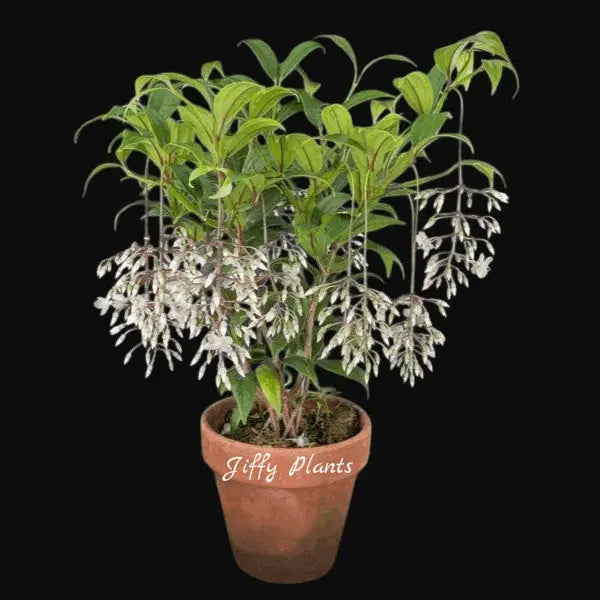
Medinilla Lalique (Medinilla Alata Lalique)
Single Plant | 2.5" Pot Included
Medinilla Lalique (Medinilla alata Lalique) is a stunning tropical plant known for its cascading clusters of lavender-blue bracts with translucent white blooms and burgundy stems. It's often called a "Chandelier Plant" due to its graceful appearance. While it might seem exotic, with the right conditions, it can thrive as a houseplant.
Here's a comprehensive care guide for your Medinilla Lalique (Medinilla Alata Lalique):
1. Light:
Bright, filtered light is key. Medinilla Lalique loves bright light but absolutely no direct sunlight, especially in the afternoon. Direct sun will scorch its leaves.
Place it near a window with blinds or sheer curtains, or in a spot where it receives bright, indirect light throughout the day.
If grown outdoors, ensure it's in a shaded area.
2. Water:
Keep the soil consistently moist but never soggy. Medinillas appreciate drying out slightly between waterings.
Allow the top inch or two of soil to dry before watering thoroughly.
Ensure your pot has excellent drainage to prevent root rot. Never let the plant sit in standing water.
Reduce watering frequency in winter when the plant's growth slows down.
Drooping foliage can indicate dehydration; if the soil is dry, soak the plant for about 15 minutes to rehydrate.
3. Humidity:
High humidity is crucial. Medinillas are tropical plants and thrive in environments with 50% humidity or higher.
To increase humidity:
Mist the leaves daily (especially in dry winter months).
Place the pot on a pebble tray filled with water (ensure the pot isn't sitting directly in the water).
Use a room humidifier near the plant.
Group it with other plants, as this can create a microclimate with higher humidity.
Avoid placing it near air ducts or drafty windows, as this can lead to dry leaf tips and edges.
4. Temperature:
Medinilla Lalique prefers warm environments, ideally between 17°C and 27°C (63°F and 80°F).
Avoid temperatures below 10°C (50°F), as this can cause leaves to yellow and drop.
Cooler nights (around 16-21°C or 60s°F) can help encourage more flowers.
5. Soil:
Use a very well-draining, organic potting mix that retains some moisture.
A mix formulated for orchids with some peat moss mixed in can be suitable, as Medinilla grows epiphytically in the wild.
Slightly acidic soil is preferred.
6. Fertilizer:
Medinilla is not a heavy feeder.
Fertilize every two weeks from spring to autumn (the growing season) with a half-dilution of a balanced liquid fertilizer.
During the flowering period, you can use a fertilizer formulated to encourage blooming.
Do not fertilize in winter when the plant is dormant.
7. Repotting:
Repotting is typically needed every 1-2 years or when the plant becomes root-bound (roots are growing out of the drainage holes).
Repot in spring, after the flowering season.
Choose a pot that is only 2-5 cm (1-2 inches) larger than the previous one.
Be gentle with the roots during repotting to avoid transplant shock.
8. Pruning:
You can prune your Medinilla after the flowering period to maintain its size and shape, and to encourage bushier growth.
Always leave at least one leaf set on each stalk you cut to prevent the stalk from dying back completely.
Deadhead spent blooms to promote new flowers.
9. Pests and Problems:
Medinillas are generally not highly susceptible to pests, but stressed plants can attract mealybugs, scale, and spider mites.
Symptoms and Solutions:
Brown/black leaves or leaf drop: Often caused by overwatering. Let the soil dry out more between waterings and ensure good drainage.
Dark brown patches or drying/blackening leaves: Insufficient light or excess fertilizer. Move to a brighter spot or adjust fertilizer.
Dry leaf tips/edges: Underwatering or low humidity. Water more regularly and increase humidity (misting, pebble tray, humidifier). Check for drafts.
Dry round patches on leaves: Direct sun exposure. Move to a bright, filtered light location.
Limp leaves and stems: Dehydration. Soak the plant if the soil is dry. If the soil is wet, it could be root rot, requiring repotting and root inspection.
No flowers: Lack of sufficient light, humidity, or fertilizer. Ensure all conditions are met, and consider a bloom-boosting fertilizer.
Yellowing leaves: Can be from too little sunlight, underwatering, or nutrient deficiency.
Small, round grains on undersides of leaves: These are natural growth sugars and are a sign of healthy growth, not pests or disease.
By providing consistent care and observing your Medinilla 'Lalique' for any signs of distress, you can enjoy its spectacular blooms for many years.

